 |
| image by Dan Hancox |
Crustaceans are violent types, posturing and fighting for territories, mating partners, and resources. Because claws are such excellent weapons, fights are often decided by the individuals merely checking each others' claws out. Bigger claws = dominance. This ameliorates the risks associated with claw-battle, while still deciding dominance.
But Candice has found that the size of the claw is not always indicative of its strength - namely, some individuals are fakers. You see, claw muscles - which are used to clamp and tear in a fight situation - are hidden inside the chitinous claw. So a big-clawed crustacean might just lack big muscles underneath, meaning it's more likely to lose if the interaction escalates into a fight.
So why wouldn't a crustacean just grow the muscle? This is what Candice wondered. She noticed that crabs with re-generated claws tended to have wimpy claws, relative to their claw size. So, she measured the energy needed to maintain claw muscles in fiddler crabs with strong, original claws as well as crabs with weak, regenerated claws.
Candice believes that dishonesty in fiddler crabs is related to metabolic costs - namely, how much energy is required to keep that muscle active. Crabs with strong, original claws spent ~22% of their metabolic energy budget on their claw muscle - pretty close to the amount of metabolic energy humans use to support our large glucose-hungry brains.
In contrast, crabs with weak, re-generated claws used only ~12% of their daily energy on claw muscle.
That constitutes a massive energetic savings for fakers, unless they get caught ...



Its a really nice billet to read and incur information.
ReplyDeletegoldenslot
สูตรบาคาร่า